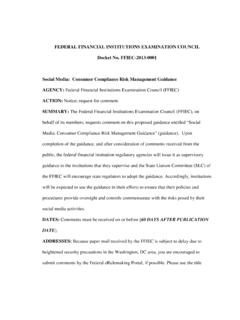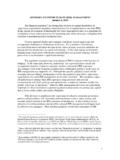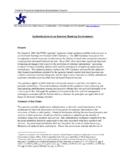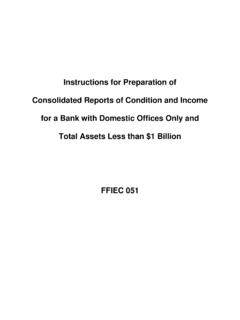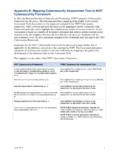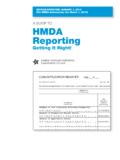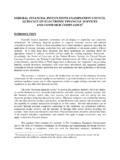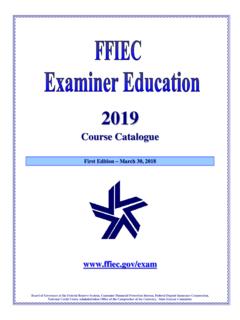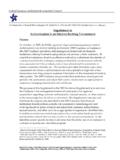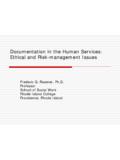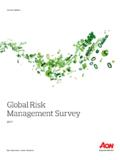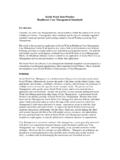Transcription of ~~ Social Media: Consumer Compliance Rislc …
1 Federal Financial Institutions Examination Council~~3501 Fairfax Drive Room B7081a Arlington, VA 22226-3550 (703) 516-5588 FAX (703) 562-6446 Media: Consumer Compliance Rislc Management GuidanceAGENCY: Federal Financial Institutions Examination Council (FFIEC).ACTION: Notice; final ~[AYZY: The Federal Financial Institutions Examination Council (FFIEC), onbehalf of its members, is issuing this final supervisory guidance entitled " Social Media: Consumer Compliance Risk Management guidance " ( guidance ). The guidance is beingpublished after consideration of comments received from the public. The Office of theComptroller of the Currency (OCC); the Board of Governors of the Federal ReserveSystem (Board); the Federal Deposit Insurance Corporation (FDIC); the National CreditUnion Administration (NCUA); and the Consumer Financial Protection Bureau (CFPB)(collectively, the Agencies) will use it as supervisory guidance for the institutions thatthey supervise, and the State Liaison Committee (SLC) of the FFIEC encourages stateregulators to adopt the guidance .]
2 Accordingly, financial institutions are expected to usethe guidance in their efforts to ensure that their policies and procedures provide oversightand controls commensurate with the risks posed by their involvement with Social : Effective FURTHER INFORMATION CONTACT:OCC: Eric Gott, Compliance Specialist, Office of the Comptroller of theCurrency, 400 7th Street SW., Washington DC, 20219, (202) : Lanette Meister, Senior Supervisory Consumer Financial ServicesAnalyst, Board of Governors of the Federal Reserve System, 20th and C Streets NW.,Washington, DC 20551, (202) : Elizabeth Khalil, Senior Policy Analyst, Federal Deposit InsuranceCorporation, 550 17th Street NW., Room F-6016, Washington, DC, 20429-0002, (202) : Robert J.
3 Polcyn, Consumer Compliance Policy and Outreach Analyst,National Credit Union Administration, 1775 Duke Street, Alexandria, VA 22314, (703) : Edna Boateng, Senior Consumer Financial Protection Analyst, ConsumerFinancial Protection Bureau, 1700 G Street, NW., Washington, DC 20552, (202) : Matthew Lambert, Policy Counsel, Conference of State Bank Supervisors,1129 20th Street NW., 9th Floor, Washington, DC 20036, (202) INFORMATION:I. Background InformationThe FFIEC is publishing this guidance to address the applicability of federal consumerprotection and Compliance laws, regulations, and policies to activities conducted viasocial media by banks, savings associations, and credit unions, as well as by nonbankentities supervised by the Consumer Financial Protection Bureau (CFPB) (collectively,financial institutions).
4 The guidance does not impose any new requirements on financialinstitutions. Rather, it is a guide to help financial institutions understand the applicabilityof existing requirements and supervisory expectations associated with the use of socialmedia. Financial institutions are expected to manage risks associated with all types ofconsumer and customer communications, no matter the medium. The guidance providesconsiderations that financial institutions may find useful in conducting risk assessmentsand crafting and evaluating policies and procedures regarding Social media. Thus, ratherthan discouraging the use of Social media or establishing any new obligations related tothe use of this technology, the guidance is intended to help financial institutionsunderstand and successfully manage risks in this six members of the FFIEC are the Office of the Comptroller of the Currency (OCC);the Board of Governors of the Federal Reserve System (Board); the Federal DepositInsurance Corporation (FDIC); the National Credit Union Administration (NCUA); theConsumer Financial Protection Bureau (CFPB) (collectively, the Agencies); and the StateLiaison Committee (SLC).
5 As part of its mission, the FFIEC makes recommendationsregarding supervisory matters and the adequacy of supervisory tools to the Agencies. TheFFIEC also develops procedures for examinations of financial institutions that are usedby the Agencies. The Agencies expect that all financial institutions they supervise willeffectively assess and manage risks associated with activities conducted via Social Agencies and SLC will use this guidance to the extent consistent with theirrespective authorities. After consideration of comments received from the public, theFFIEC is issuing this document on behalf of its members as guidance to the institutionsthat the member Agencies supervise. Accordingly, such institutions are expected to usethe guidance in their efforts to ensure that their risk management and consumerprotection practices adequately address Consumer Compliance and legal risks, as well asrelated risks, such as reputation and operational risks, raised by activities conducted viasocial media.
6 The SLC, which is composed of representatives of five state agencies thatsupervise financial institutions, was established to encourage the application of uniformexamination principles and standards by state and federal supervisory agencies. The SLCencourages the adoption of the guidance by state regulators. State agencies that adopt theGuidance will expect the entities that they regulate to use the guidance in their efforts toensure that their risk management and Consumer protection practices adequately addressthe Compliance and reputation risks raised by activities conducted via Social media has been defined in a number of ways. For purposes of the guidance , socialmedia is a form of interactive online communication in which users can generate andshare content through text, images, audio, and/or video.
7 Social media can take manyforms, including, but not limited to, micro-blogging sites ( , Facebook, Google Plus,MySpace, and Twitter); forums, blogs, customer review web sites and bulletin boards2( , Yelp); photo and video sites ( , Flickr and YouTube); sites that enableprofessional networking ( , LinkedIn); virtual worlds ( , Second Life); and socialgames ( , FarmVille and CityVille). Social media can be distinguished from otheronline media in that the communication tends to be more interactive. For purposes of thisGuidance, messages sent via email or text message, standing alone, do not constitutesocial media, although such communications may be subject to a number of laws andregulations discussed in this guidance .
8 Social media is a dynamic and constantlyevolving technology and thus any definition for this technology is meant to be illustrativeand not e~austive. In addition to the examples of Social media mentioned above, otherforms of Social media may emerge in the future that financial institutions should institutions may use Social media in a variety of ways, including marketing,providing incentives, facilitating applications for new accounts, inviting feedback fromthe public, and engaging with existing and potential customers, for example, by receivingand responding to complaints, or providing loan pricing. Since this form of customerinteraction tends to be both informal and dynamic, and may occur in a less secureenvironment, it can present some unique challenges to financial institutions.
9 ~d> ~'e encipal Elements of GuidanceThe use of Social media by a financial institution to attract and interact with customerscan impact a financial institution's risk profile. The increased risks can include the risk ofharm to consumers, Compliance and legal risk, operational risk, and reputation risk can arise from a variety of directions, including poor due diligence,oversight, or control on the part of the financial institution. This guidance is meant tohelp financial institutions identify potential risk areas to appropriately address, as well asto ensure institutions are aware of their responsibilities to oversee and control these riskswithin their overall risk management program. The Agencies and the SLC recognize thatthe scope of Social media activities vary by financial institution.
10 Each institution isresponsible for carrying out an appropriate risk assessment and maintaining a riskmanagement program that is appropriate and tailored to the particular institution's size,activities, and risk Comments ReceivedOn January 23, 2013, the FFIEC issued proposed guidance in response to requestsarticulated to the Agencies by various participants in the industry for guidance regardingthe application of Consumer protection laws and regulations within the realm of socialmedia. 78 FR 4848 (Jan. 23, 2013). The FFIEC invited comments on any aspect of theproposal. In addition, the FFIEC specifically solicited comments in response to thefollowing questions:1. Are there other types of Social media, or ways in which financial institutionsare using Social media, that are not included in the proposed guidance but thatshould be included?
